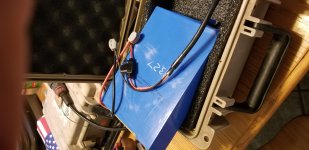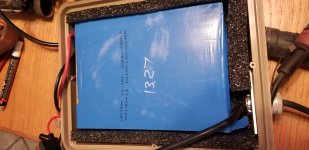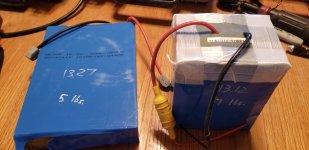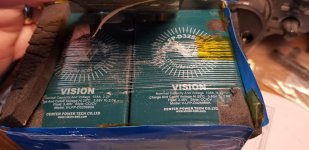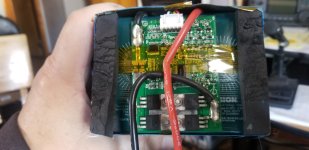You are using an out of date browser. It may not display this or other websites correctly.
You should upgrade or use an alternative browser.
You should upgrade or use an alternative browser.
Picked up some Lifepo.. Ratings?
- Thread starter torker
- Start date
At a guess, if they are fused for 10A, then some component within them is incapable of safely handling more than that. Otherwise they should be fused at whatever they are safely capable of handling.
They could have just used a random fuse, but in that case they could've used random other parts too, and I'd trust a battery built like that even less.
If they are used packs, then I'd assume the condition is very well used and not nearly as capable as they were when new, until proven otherwise by testing. There is a number on one of them that looks like a datecode (and possibly serial number) under the word HETER, which starts with 2014. If that's the year of manufacture, then assuming the cells are the same age and not older, the pack is 8 years old. Whether or not it's been used a lot in that time, calendar life is shorter now by that much, and capabilities lessened by that much as well (different for different cells, no specs on those so safest to assume worst-case). I'd guess the handwritten number on each is it's present capacity, vs the marked capacity. In this case, it means the capabilities have probably degraded quite a bit from original.
If they have a BMS, and that is marked with it's capabilities, then you can use them up to whatever those are. If it's not marked then you can try searching for whatever model info it has on it, if any, and seeing if that comes up with ratings. If not, then you can only guess. If the FETs are marked with their part numbers, you can look up what those are capable of and make an educated guess what the total BMS rating might be by that multiplied by the number of FETs, assuming they are driving them correctly to turn them on fully (if not, they won't handle the full current they're rated for as their resistance will be higher when on, and they'll create more heat). This, of course, only keeps the BMS safe from overcurrent damage, not the cells.
If there is no BMS, then unless the cells have markings and you can find a link in a search somewhere that gives the cell specs, you have nothing to go on for capabilities besides the fuse rating.
Like other chemistries, cell capability varies greatly by specific cell design/manufacturing. Some LiFePO4 cells can handle 2C fine (which would be 40A in this case, 2x 20Ah), some will sag in voltage and heat up internally, potentially dangerously or damagingly so, at that rate, and could only handle much less, such as 0.5C (which would be 10A in this case, 0.5x 20Ah).
If you have access to actual cell terminals in the pack, you can test for voltage drop under load, and test the pack at various current draws, at about half-full capacity. If there is significant voltage sag, or you have some cells that sag significantly more than others, then lower the current until this doesn't happen, and that's the limit the cells can really handle.
As for seriesing them, if they have BMSs then the info in the various threads about series BMS applies, and you'd have to decide if the risk is worth it or if the solutions in them (diodes, etc) are applicable or possible for your use case.
https://endless-sphere.com/forums/search.php?keywords=series*+batt*&terms=all&author=&sc=1&sf=titleonly&sr=topics&sk=t&sd=d&st=0&ch=300&t=0&submit=Search
https://endless-sphere.com/forums/search.php?keywords=series*+pack*&terms=all&author=&sc=1&sf=titleonly&sr=topics&sk=t&sd=d&st=0&ch=300&t=0&submit=Search
https://endless-sphere.com/forums/search.php?keywords=series*+bms*&terms=all&author=&sc=1&sf=titleonly&sr=topics&sk=t&sd=d&st=0&ch=300&t=0&submit=Search
If they have no BMS then you can series them like any other bare cells.
They could have just used a random fuse, but in that case they could've used random other parts too, and I'd trust a battery built like that even less.
If they are used packs, then I'd assume the condition is very well used and not nearly as capable as they were when new, until proven otherwise by testing. There is a number on one of them that looks like a datecode (and possibly serial number) under the word HETER, which starts with 2014. If that's the year of manufacture, then assuming the cells are the same age and not older, the pack is 8 years old. Whether or not it's been used a lot in that time, calendar life is shorter now by that much, and capabilities lessened by that much as well (different for different cells, no specs on those so safest to assume worst-case). I'd guess the handwritten number on each is it's present capacity, vs the marked capacity. In this case, it means the capabilities have probably degraded quite a bit from original.
If they have a BMS, and that is marked with it's capabilities, then you can use them up to whatever those are. If it's not marked then you can try searching for whatever model info it has on it, if any, and seeing if that comes up with ratings. If not, then you can only guess. If the FETs are marked with their part numbers, you can look up what those are capable of and make an educated guess what the total BMS rating might be by that multiplied by the number of FETs, assuming they are driving them correctly to turn them on fully (if not, they won't handle the full current they're rated for as their resistance will be higher when on, and they'll create more heat). This, of course, only keeps the BMS safe from overcurrent damage, not the cells.
If there is no BMS, then unless the cells have markings and you can find a link in a search somewhere that gives the cell specs, you have nothing to go on for capabilities besides the fuse rating.
Like other chemistries, cell capability varies greatly by specific cell design/manufacturing. Some LiFePO4 cells can handle 2C fine (which would be 40A in this case, 2x 20Ah), some will sag in voltage and heat up internally, potentially dangerously or damagingly so, at that rate, and could only handle much less, such as 0.5C (which would be 10A in this case, 0.5x 20Ah).
If you have access to actual cell terminals in the pack, you can test for voltage drop under load, and test the pack at various current draws, at about half-full capacity. If there is significant voltage sag, or you have some cells that sag significantly more than others, then lower the current until this doesn't happen, and that's the limit the cells can really handle.
As for seriesing them, if they have BMSs then the info in the various threads about series BMS applies, and you'd have to decide if the risk is worth it or if the solutions in them (diodes, etc) are applicable or possible for your use case.
https://endless-sphere.com/forums/search.php?keywords=series*+batt*&terms=all&author=&sc=1&sf=titleonly&sr=topics&sk=t&sd=d&st=0&ch=300&t=0&submit=Search
https://endless-sphere.com/forums/search.php?keywords=series*+pack*&terms=all&author=&sc=1&sf=titleonly&sr=topics&sk=t&sd=d&st=0&ch=300&t=0&submit=Search
https://endless-sphere.com/forums/search.php?keywords=series*+bms*&terms=all&author=&sc=1&sf=titleonly&sr=topics&sk=t&sd=d&st=0&ch=300&t=0&submit=Search
If they have no BMS then you can series them like any other bare cells.
torker said:I picked up some Lifepo locally. Wondering if I can pull 20 amps on these. They are 20 ah and fused at 10a right now. Also wondering if I can series these/how? Thanks View attachment 2View attachment 1
torker
100 kW
Thanks Amberwolf They do have bms. I have not opened one yet. The guy i got them from has a whole pallet full. Some were puffed. These were used for some kind of geolocating sensors of some type. just left in the field to power something. The writing is mine when i received them. the initial voltage. I could probably go back to the guy and we could open up some puffed ones. I hate to cut into these.
I planned to use the squarish :? ones for a ebike maybe. I will check out those links. I assume using diodes?
I planned to use the squarish :? ones for a ebike maybe. I will check out those links. I assume using diodes?
999zip999
100 TW
What voltage are the packs. How many in series ?what are you going to use them for ?
Looking at photos 12 v.or for in series ? Maybe.
Looking at photos 12 v.or for in series ? Maybe.
torker
100 kW
They are nominally 12.8v max 14.6 v I checked the links and saw a diagram that Fetcher posted then lost the page somehow... Looks like I need the correct diodes to combine these to series these.. I may just keep these for my solar setup. I already paralelled 2 for that..
CONSIDERABLE SHOUTING
10 kW
- Joined
- Jun 15, 2019
- Messages
- 812
Sound almost like lead acid battery replacements. Do you have any way to test them outside of voltage- Internal resistance, capacity ect?
torker
100 kW
I do have an old Turnigy watt meter. I could rig up a resistive load.
torker
100 kW
That is probably the best way. Break them down and get the proper bms. A little out of my comfort zone.
Use to be an apprentice electrical mechanic. Back surgery and then a stroke took me out of that industry. Ten years out of practice...
I do have some ham radio friends that are better at building electronics than I. I may get some help.
Use to be an apprentice electrical mechanic. Back surgery and then a stroke took me out of that industry. Ten years out of practice...
I do have some ham radio friends that are better at building electronics than I. I may get some help.
torker
100 kW
Similar threads
- Replies
- 0
- Views
- 208
- Replies
- 5
- Views
- 142
- Replies
- 2
- Views
- 471


